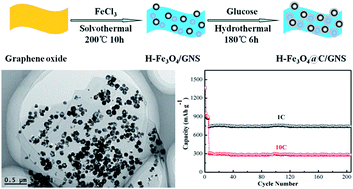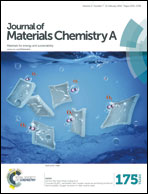Hybridization of graphene nanosheets and carbon-coated hollow Fe3O4 nanoparticles as a high-performance anode material for lithium-ion batteries†
Abstract
Fe3O4 has long been regarded as a promising anode material for lithium ion batteries due to its high theoretical capacity, earth abundance, low cost, and nontoxic properties. At present, no effective method has been realized to overcome the bottleneck of poor cyclability and low rate capability because of its huge volume change and low electrical conductivity. In this article, a facile synthesis strategy is developed to fabricate two-dimensional (2D) carbon encapsulated hollow Fe3O4 nanoparticles (H-Fe3O4 NPs) homogeneously anchored on graphene nanosheets (designated as H-Fe3O4@C/GNSs) as a durable high-rate lithium ion battery anode material. In the constructed architecture, the thin carbon shells can avoid the direct exposure of encapsulated H-Fe3O4 NPs to the electrolyte and preserve the structural and interfacial stabilization of H-Fe3O4 NPs. Meanwhile, the flexible and conductive GNSs and carbon shells can accommodate the mechanical stress induced by the volume change of H-Fe3O4 NPs as well as inhibit the aggregation of Fe3O4 NPs and thus maintain the structural and electrical integrity of the H-Fe3O4@C/GNSs electrode during the lithiation/delithiation processes. As a result, the H-Fe3O4@C/GNSs electrode exhibits outstanding reversible capacity (870.4 mA h g−1 at a rate of 0.1C (1C = 1 A g−1) after 100 cycles) and excellent rate performance (745, 445, and 285 mA h g−1 at 1, 5, and 10C, respectively) for lithium storage. More importantly, the H-Fe3O4@C/GNSs electrode demonstrates prolonged cycling stability even at high charge/discharge rates (only 6.8% capacity loss after 200 cycles at a high rate of 10C). Our results show that the 2D H-Fe3O4@C/GNSs are promising anode materials for next generation LIBs with high energy and power density.


 Please wait while we load your content...
Please wait while we load your content...